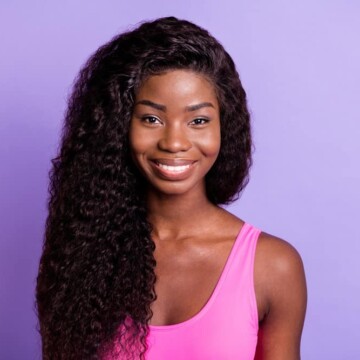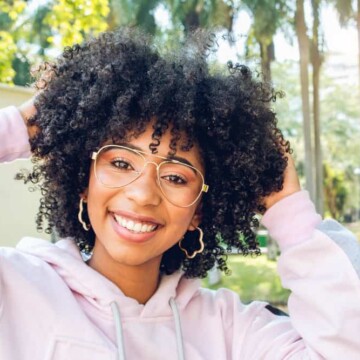
The easiest DIY starter loc method of all is, arguably, two-strand twists. After all, everyone can twist two strands of hair together. Yet, there are some ins and outs that you need to be familiar with before you take the plunge.
That's what we'll be covering in this article - we'll tell you why we recommend starting locs with two-strand twists, who should use this method, how to do two-strand twists, and the dos and don'ts you should follow.
Table of Contents
- 1 Key Takeaways
- 2 How Two-Strand Twist Starter Locs Work
- 3 Starting Locs with Two Strand Twists: DIY Process
- 4 The Locking Process for Twist Locs
- 5 Frequently Asked Questions
- 5.1 Is It Better to Start Locs With Two-Strand Twists?
- 5.2 How Long Does It Take for Two-Strand Twists to Loc?
- 5.3 Can Regular Two-Strand Twist Turn Into Dreads?
- 5.4 Do Two-Strand Twist Locs Help Hair Grow?
- 5.5 Why Does Hair Grow Faster in Locs?
- 5.6 Do Two-Strand Twist Starter Locs Get Thicker?
- 5.7 How Do I Make My Starter Locs Thicker?
- 5.8 Related Articles
- 6 Dos and Don'ts of Two Strand Twist Starter Locs
Key Takeaways
- Starting Two-Strand Twist Locs: The initial step for creating twist locs involves ensuring your hair is clean and moisturized. It's crucial to use a clarifying shampoo and a moisturizing conditioner to prepare the hair, especially for those with curly or natural hair types.
- Deciding Loc Size and Parting: Choose the size of the locs based on hair length and texture, with options ranging from microlocs to jumbo locs. Parting systems like square, crescent, organic, or diamond determine the twist pattern and overall appearance of the starter loc style.
- Twisting Technique: For creating strand twist locs, divide hair into sections using a comb, twist strands in opposite directions, and secure with elastic bands if necessary. This method is suitable for various hair types, including curly and natural hair.
- Maintenance and Growth Phases: Regular retwisting is essential for proper maintenance, especially in the beginning stages of baby locs. You can use natural oils and avoid products like wax to prevent buildup and fungal infections.
- Locking Process and Aftercare: Expect the locking process to take six months to a year, with possible unraveling and frizz in the early stages. Using essential oils and wearing a satin cap can help maintain the health and appearance of new and maturing locs.
How Two-Strand Twist Starter Locs Work
To do two-strand twist starter locs, you'll need to twist sections of your hair from roots to ends and leave them alone to lock on their own.
When your hair is first twisted, it will look like regular twists, but over time your twists will develop into beautiful traditional locs - a bit thicker than interlocked locs or braid locs.
You can maintain your twist locs with retwisting or interlocking, based on your preferences. Anyone with a few inches of hair can start their locs with this method.
Starting Locs with Two Strand Twists: DIY Process
Though doing two-strand twists is pretty straightforward, there are several ways that things can go wrong. So, here are some step-by-step instructions to follow:
How To Start Locs With Two Strand Twist
Before twisting your hair up, you should ensure that your hair is clean, conditioned, and moisturized. For the best results, you should use a clarifying shampoo to lift away any buildup you may have.
If you twist up your hair while it's dirty, all of that gunk will get trapped in your locs.
After getting your locs clean, follow up with a moisturizing conditioner to replenish some of that lost moisture.
If your hair feels especially dry, feel free to deep condition it. Finish your hair prep with a penetrating moisturizer or oil. Apply it throughout your hair so that every strand is covered, but don't apply too much.
Decide on Your Loc Size and Parting System

The size of your parts will determine your final loc size. Larger parts will result in larger locs, while smaller parts will result in smaller locs.
Locs come in various sizes, from microlocs and sisterlocks (the smallest of them all) to extra-large congos and wicks. The size of your locs is totally up to you, but two-strand twists work best for medium to thick locs.
Once you've decided on your loc size, it's time to part your first section.
This is where many people go wrong - if you make your parts too large or too small, your locs won't end up the correct size. To help you out, here are some sizing guidelines to follow:
- Microlocs - Make your parts ¾ of an inch or less.
- Small locs (pencil-sized) - Make your parts about an inch to 1 ¼ inches.
- Medium locs (pen-sized) - Make your parts between 1 ¼ and 1 ½ inches.
- Thick locs (sharpie sized) - Make your parts between 1 ½ to 1 ¾ inches.
- Jumbo locs (larger than sharpie sized) - Make your parts between 1 ¾ to 2 inches.
Once you determine what size you need to make your locs, it's time to choose a parting system. Here's some information about all of them:
- Square - Square parts are suitable for anyone who doesn't want to bother with other more intricate parting techniques. When doing square parts, it's best to use a bricklaying pattern to minimize the amount of scalp that'll show after your locks are mature. A great thing about square parts is that they have straight sides, so parting them according to the size recommendations above will be easy.
- Crescent - Crescent parting requires you to make half-moon-shaped sections. They tend to make your locs look more organic. To create these parts, we recommend looking at some YouTube videos or pictures of crescent parts.
- Organic - Organic parting is the most carefree parting option, involving grabbing sections of hair with your fingers. You should still try to get the parts the same size, but if you're doing organic parts, neatness isn't a big factor.
- Diamond - Diamond parts are not as common as some of the other parting systems. And that’s likely because this parting system is very challenging to achieve at home. We think we can all agree that there's something very striking about diamond parts.
Now that you've chosen your loc size and parting system, you're ready to make your first section!
Part and Twist
- Section your hair into four equal sections with a rattail comb. If you're doing square or diamond parts, the parts need to be absolutely straight.
- Secure each section with an elastic band. This will make your hair easier to work with. You don’t want to accidentally grab hair from another section.
- Make your first part in one of the back sections according to the parting system and loc size you want.
- After the part is made, separate the section into two strands and cross one strand over the other repeatedly until you reach the ends. If you want your twists to be more sturdy, twist both strands to the right, and overlap to the left repeatedly. This will give the twist more of a rope-like appearance. Be sure to twist all of your twists in the same direction.
- Continue parting and twisting until all of your hair is twisted.
- If your scalp feels dry, oil it with olive oil, jojoba oil, or any other oil you like.

The Locking Process for Twist Locs
Twist locs will get frizzier and frizzier in the baby loc and teenage phases. There's no way around it. In addition to the frizz, you will likely notice some shrinkage - it can be extensive in some cases, depending on the texture of your hair.
Lastly, your twists may unravel quite a bit throughout the first few weeks, even to the point of frustration. If you notice a twist or two unraveling here and there, just twist them back down to the ends.
With two-strand twists locs you should retwist your hair every four or more weeks. If you prefer to interlock your new growth, do so every eight weeks or more.
Two-strand twist starter locs can take anywhere from 6 months to a year or more to lock. They may start budding by month 3. The amount of time it takes to lock will depend on the texture of your hair, how often you wash your starter locs, and more.
Frequently Asked Questions
Welcome to our FAQ section on starting locs with two-strand twists. Here, we address common questions and provide clear, concise answers to help you on your journey to beautiful, healthy locs.
Is It Better to Start Locs With Two-Strand Twists?
Starting locs with two-strand twists is often considered one of the easiest methods, especially for those with curly hair or natural hair textures. This technique provides a solid foundation for new locs, allowing hair strands to naturally intertwine and lock over time. The suitability of this method can vary based on personal preference, hair type, and desired loc thickness. Two-strand twists are a great way to begin the loc journey, especially for those looking for a simple, step-by-step guide to achieve beautiful two-strand twists as their end goal.
How Long Does It Take for Two-Strand Twists to Loc?
The process of two-strand twists transitioning into locs typically takes anywhere from 6 months to a year. The specific time frame can depend on factors like hair texture, the frequency of washing and retwisting sessions, and the use of appropriate hair products. The twists mature into locs during this period, passing through an awkward phase where hair may unravel or appear frizzy.
Can Regular Two-Strand Twist Turn Into Dreads?
Regular two-strand twists can evolve into dreads (locs) over time. This natural progression occurs as the twisted hair begins to lock and intertwine at the roots and along the hair strands. Regular maintenance, such as retwisting, helps guide the hair into the loc formation. The transition from twists to locs is a process that reflects the natural beauty and evolution of hair.
Do Two-Strand Twist Locs Help Hair Grow?
Two-strand twists can help hair growth by protecting the hair strands from excessive manipulation and breakage. This protective style keeps the hair secure and minimizes damage, allowing the hair follicles to strengthen and grow. While the locs don't directly cause hair growth, they provide an environment conducive to retaining length and promoting healthy hair.
Why Does Hair Grow Faster in Locs?
Hair often grows faster in locs due to reduced breakage and length retention. Locs protect the hair from daily wear and tear, allowing natural oils to coat the hair strands more effectively. This protection and nourishment help maintain hair health, leading to less breakage and, as a result, the appearance of faster growth.
Do Two-Strand Twist Starter Locs Get Thicker?
Two-strand twist starter locs can become thicker as they mature. The locs naturally expand and strengthen over time as the hair locks and intertwines. The initial size of the twists, hair texture, and maintenance routine plays a significant role in determining the final thickness of the locs.
How Do I Make My Starter Locs Thicker?
To make starter locs thicker, begin with larger sections of hair when creating the initial two-strand twists. This provides a larger base for the locs to form. Deep conditioning treatments and natural oils can help maintain healthy hair, contributing to fuller and thicker locs. Additionally, minimizing manipulation and retwisting only when necessary can help the natural thickening process as the locs mature.
- Dreadlocks Growth Stages
- Palm Rolling Dreads
- How To Install Dread Extensions (i.e., similar to faux locs)
- The Stages of Locs
Dos and Don'ts of Two Strand Twist Starter Locs

Here are some dos and don'ts to follow when you're doing your two-strand twist starter locs:
Dos
- Add a lightweight gel to the sections before twisting if you want to reduce frizz. Just remember that, eventually, your twists will get frizzy. It's part of the locking process.
- Make sure your hair is clean and moisturized before twisting. Dirty hair can result in hard-to-remove flakes and buildup.
- Rub some witch hazel onto your scalp to combat itchiness.
- Finger coil the ends of your twists to help keep them from unraveling. You could also put rubber bands on the ends of your twists for a few weeks if your hair has a loose texture, but we recommend using finger coils if possible.
Don'ts
- Don't use wax on your twists. Wax can suffocate your hair, cause buildup, and attract dust and debris.
- Don't repeatedly style your new two-strand twist starter locs. The more you manipulate them, the more unraveling you may experience.
We hope that this article is helpful to you as you take steps to start your locs with the two-strand twist method. If this method sounds too complex, check out this article on installing faux locs. We wish you the best as you embark upon your loc journey!




